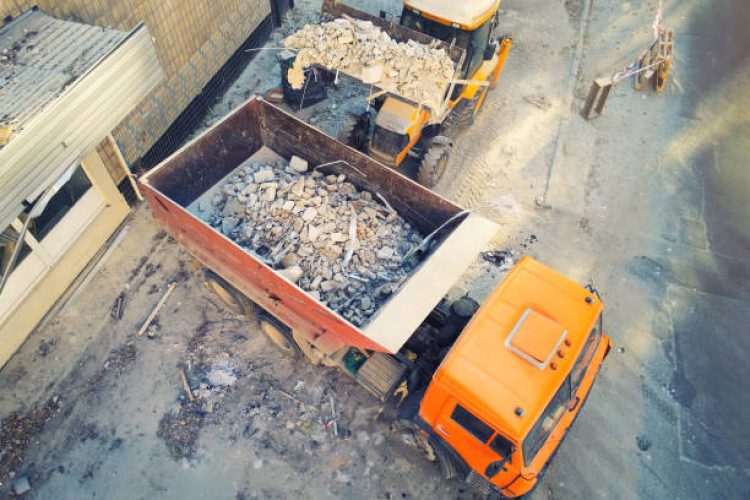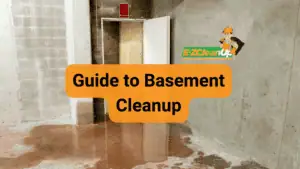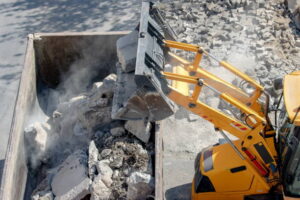Adding demolition work to your cleanup project is a major undertaking that requires careful planning, specialized expertise, and a clear understanding of what lies ahead. Whether you’re renovating a home, clearing a commercial site, or preparing land for new construction, knowing what to expect can help you avoid costly surprises and ensure a safe, efficient process.
Understanding the Demolition Cleanup Process
After a demolition project, the cleanup process is a critical and highly organized phase to restore the site and prepare for future construction. Unlike standard cleanup projects, demolition cleanup involves managing massive amounts of debris, coordinating with multiple stakeholders, and adhering to strict safety regulations.
What Makes Demolition Cleanup Different?
Construction debris removal involves systematically clearing waste materials generated during building, renovation, or demolition activities. These materials typically include broken concrete, discarded lumber, metal scraps, drywall remnants, and other construction byproducts that accumulate throughout a project’s lifecycle.
The scope of demolition cleanup extends far beyond simply hauling away rubble. It encompasses site safety, environmental compliance, proper waste sorting, and preparation for the next phase of your project.
Planning and Preparation: The Critical First Steps
Engineering Survey and Safety Assessment
Before any demolition work begins, proper planning is essential. Proper planning is essential to ensure a demolition operation is conducted with no accidents or injuries. This includes, but is not limited to: An engineering survey completed by a competent person before any demolition work takes place. This should include the condition of the structure and the possibility of an unplanned collapse.
According to OSHA regulations, this engineering survey is not optional—it’s mandatory. 1926.850(a)(1), which requires an “engineering survey” to be completed prior to starting demolition, accounts for more than half these preparatory operations citations.
Utility Disconnection
Utility lines such as water, gas, and electricity are disconnected to avoid any dangers during the cleanup process. Planned collaboration with utility providers helps ensure that safe disconnection of services occurs before demolition goes forward. This critical step prevents accidents and ensures worker safety throughout the entire demolition and cleanup process.
What to Expect During the Demolition Cleanup Phase
Timeline Considerations
How long will your demolition cleanup take? Once permits are in hand, a small- to medium-sized house can be demolished in three to seven days, which includes hauling away debris and cleaning the site. Larger homes or sites with tight access can stretch the schedule.
The timeline can vary significantly based on:
- Size and complexity of the structure
- Presence of hazardous materials
- Site accessibility
- Local regulations and permit requirements
- Weather conditions
Heavy Equipment and Debris Management
Contractors quickly clear the site using heavy equipment such as excavators and bulldozers. Professional demolition teams use specialized machinery designed to efficiently break down structures and manage large volumes of debris.
Usually, large dumpsters or roll-off containers are deployed to haul debris to licensed landfills or recycling centers. Expect multiple dumpster loads for most projects, with frequent pickups scheduled to keep the site clear and safe.
Cost Factors for Demolition Cleanup
Understanding the financial investment required is crucial for proper budgeting.
Average Demolition and Cleanup Costs
House demolition costs an average of $6,000 and $25,000, with most homeowners paying an average of $15,800 for a 2,000-square-foot house. Square footage is the biggest cost factor, averaging $4 to $17 per foot. Location, permits, inspections, and cleanup also influence the final price.
A full demo leaves a mountain of debris, and you’ll pay to haul it away. Cleaning and disposal costs range from $300 to $1,800, depending on whether the materials are hazardous. Demolition contractors often include disposal and cleanup costs in their estimates, but check the itemized contract before proceeding.
Additional Cost Considerations
- Permits: Ranging from $100 to $500 on average, permit requirements apply to most demolitions.
- Hazardous materials: Asbestos removal averages $2,000.
- Debris removal: In July 2025 the estimated cost to Remove Construction Debris starts at $70.02 – $82.02 per cubic yard.
Safety Requirements and Regulations
Safety is the paramount concern in any demolition cleanup project.
OSHA Compliance
However, the hazards of demolition work can be controlled and eliminated with the proper planning, the right personal protective equipment, necessary training, and compliance with OSHA standards.
Before doing demolition work, inspect available personal protective equipment (PPE), and select, wear and use the PPE appropriate for the task. This includes hard hats, safety goggles, steel-toed boots, gloves, respiratory protection, and hearing protection.
Site Security and Public Safety
Barriers, like fences, are erected around the site to keep out trespassers and protect the public from possible harm. Frequent inspections should catch any potential hazards, and clear signage should warn the public of active demolition work.
Environmental Considerations and Waste Management
Modern demolition cleanup prioritizes environmental responsibility alongside efficiency.
Sorting and Recycling
Determine and sort types of waste after a demolition. This includes determining which materials can be recycled and which are hazardous to comply with laws and improve disposal processes.
Sorting materials like wood, metal, and concrete for recycling can reduce waste and make the cleanup more environmentally friendly. Many waste disposal companies and recycling centers accept these materials, and some may even offer rewards for recycling large amounts.
Materials That Can Be Recycled
According to the EPA, EPA estimated that 600 million tons of C&D debris were generated in the United States in 2018, which is more than twice the amount of generated MSW. Much of this can be diverted from landfills through proper recycling practices.
Common recyclable demolition materials include:
- Concrete and masonry
- Metal (steel, copper, aluminum)
- Wood and lumber
- Drywall and gypsum board
- Asphalt shingles
- Bricks and tiles
Post-Demolition Site Management
Site Cleanup and Preparation
Clean the ground and get it ready for future development with soil testing, grading, and bringing back native plants so it’s ready to go for whatever comes next.
A thorough inspection of the demolition site is essential to ensure it is free of hazards. This final inspection confirms the site is safe and ready for the next phase of construction or development.
Documentation and Compliance
A thorough post-demolition cleanup will include all necessary documentation proving that the site was properly cleared and any hazardous materials were disposed of according to regulations. This documentation can be crucial when moving forward with new construction projects or selling the property.
Working with Professional Demolition Contractors
Why Hire Professionals?
If your demolition project involves hazardous materials like asbestos or requires specialized equipment, consider hiring professionals for the job. Experienced contractors have the expertise to handle complex projects and ensure that debris is disposed of safely and legally.
Professional contractors bring:
- Specialized equipment and expertise
- Knowledge of local regulations
- Proper insurance and licensing
- Safety training and protocols
- Efficient waste management systems
Questions to Ask Your Contractor
Before hiring a demolition contractor, ensure they can answer these key questions:
- Are you licensed, bonded, and insured?
- What does your bid include (permits, cleanup, disposal)?
- How will you handle hazardous materials?
- What is your timeline for completion?
- Do you have references from similar projects?
Best Practices for Demolition Cleanup Success
Break the Project Into Phases
Break the demolition and cleanup process into manageable phases. Tackle one area at a time, removing debris as you go. This approach keeps the worksite organized and reduces the risk of accidents caused by scattered materials. Cleaning up as you work also helps maintain a safer and more efficient workflow.
Plan for Regular Debris Removal
For larger projects generating significant debris, scheduling regular dumpster pickups can prevent overloading and keep the site clear. Many dumpster rental companies offer flexible options, allowing you to arrange pickups based on your project timeline. This ensures that the cleanup process runs smoothly from start to finish.
Maintain Clear Communication
Create a robust cleanup plan that outlines the sorting of debris, transportation measures and logistics, disposal or reuse processes, and adherence to environmental regulations. Share this plan with all stakeholders and update it regularly as the project progresses.
Common Challenges and How to Overcome Them
Hidden Hazardous Materials
Older buildings may contain asbestos, lead paint, or other hazardous materials not visible during initial inspections. If your home was built before 1989, there’s a good chance its insulation or flooring hides this banned, hazardous material. Professional asbestos removal services use protective gear to carefully remove these materials ahead of demolition. They follow strict procedures and test the air quality according to Environmental Protection Agency standards to prevent asbestos exposure.
Site Access Issues
Dense urban areas mean higher labor rates and tighter regulations than rural spots. Logistical challenges, such as heavy traffic, narrow streets, and limited parking, can complicate the management of demolition vehicles and machinery. Stringent city regulations and building codes may require homeowners to follow strict rules around dust, construction noise, waste disposal, traffic management, and other factors, potentially delaying demolition progress or increasing overall costs.
Weather Delays
Local codes and weather can also extend the timeline. Build flexibility into your schedule to accommodate weather-related delays, especially for outdoor demolition work.
Conclusion: Setting Realistic Expectations
Adding demolition to your cleanup project is a complex undertaking that requires professional expertise, careful planning, and realistic budgeting. Demolition cleanup does not need to be an overwhelming task. With proper planning, the right tools, and efficient waste management, you can make the process smooth and hassle-free.
By understanding what to expect—from initial engineering surveys to final site cleanup—you can make informed decisions, avoid costly mistakes, and ensure your project proceeds safely and efficiently. Whether you’re tackling a residential renovation or a large commercial demolition, working with licensed professionals and following established safety protocols will help you achieve successful results.
Remember: proper demolition cleanup isn’t just about removing debris—it’s about creating a safe, clean foundation for whatever comes next.
References
- OSHA Demolition Standards – https://www.osha.gov/demolition
- EPA Sustainable Management of Construction and Demolition Materials – https://www.epa.gov/smm/sustainable-management-construction-and-demolition-materials
- HomeAdvisor: House Demolition Cost Guide – https://www.homeadvisor.com/cost/landscape/house-demolition/
- CalRecycle: Construction and Demolition Debris Recycling – https://calrecycle.ca.gov/condemo/
- Tri-State Disposal: How to Make Demolition Cleanup Simple – https://tri-statedisposal.com/blog/demolition-tips/













